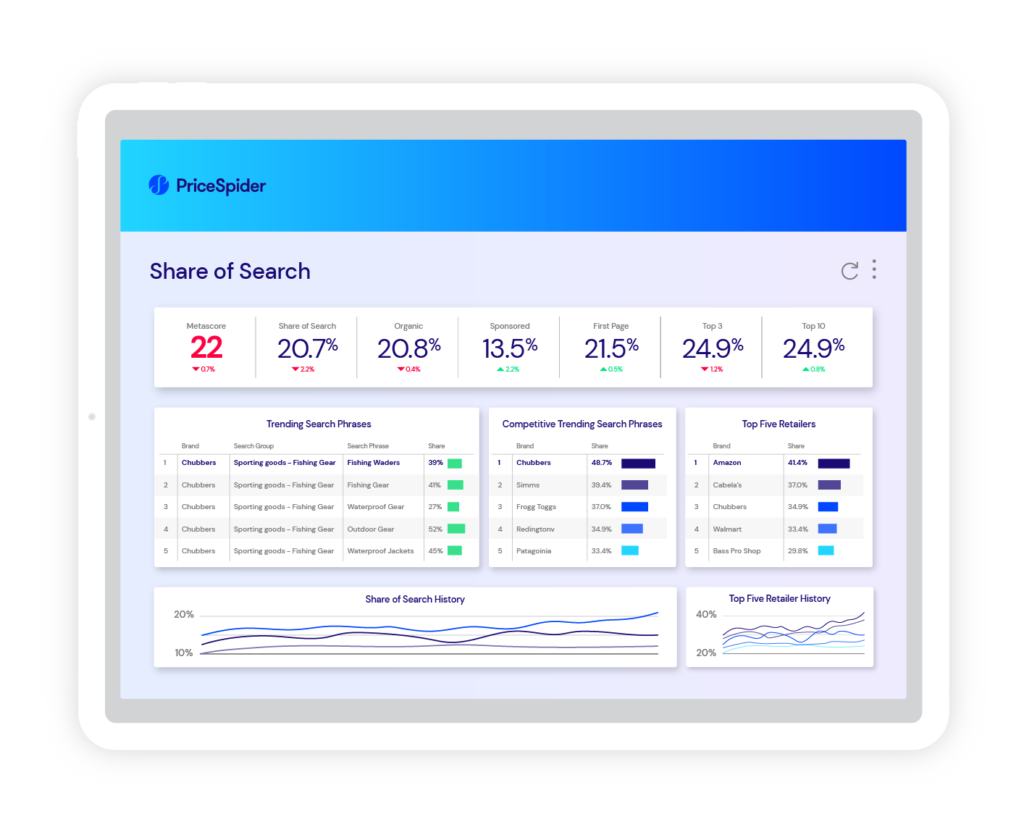Camouflage is pretty cool. Of course we’re talking about it as a concealment defense against predators or enemy soldiers. As a casual cargo pant look, it’s … fine. But one place it’s definitely not good is on a brand’s products.
Imagine your target audience is browsing a brick-and-mortar store. They’re in your aisle, exploring the options in your product category. But your products are camouflaged — hidden on the back of the shelf, tucked behind your competitors. The only way your customers will even see your product is if your competitors are out-of-stock.
That’s what it’s like when you don’t show up on the first page of a retailer’s search results. Your products have poor visibility on the digital shelf, and your target audience will only find you when the pickings are slim or they’re already looking for your brand by name.
If you want to win the digital shelf, you need to monitor your share of search. “Share of search” is the percentage of search results (organic and sponsored) your brand appears in for a given term on a retailer’s site. PriceSpider’s Brand Monitor shows you your share of search and also how often your SKUs appear on the first page and in the top 10 results.
Here’s why these share of search insights are critical to your brand’s success on the digital shelf.
See where you stand in key product categories
Your customers use a variety of phrases to describe and explore your product category. Your product descriptions, titles, ratings, and other factors influence how closely a retailer’s search engine believes your product pages match these search phrases.
Your share of search can also be indicative of how consumers who use these terms have interacted with your product page when they see it in the results. If no one is clicking your PDP in search results, your share of search may fall over time, even if your page appears to be optimized for the search term.
The phrases that matter most to your brand will completely depend on your product category, but your overall share of search will help you see how you’re doing compared to your competitors, both in terms of your organic search performance and the results you’re paying to appear in.
Track your placement on every retailer’s site
Every retailer has their own search algorithm for determining which product pages to show their customers first. And they’re all working from independent data sets. Your excellent rankings on Amazon.com won’t directly impact your share of search on Walmart.com. Your ratings don’t translate from one store to another, either. And if your product page content and images aren’t consistent, some of your pages are simply going to perform better than others.
You may be organically winning your major product categories at one retailer, but not even showing up on the first page of another. Understanding your share of search at each retailer’s site will help you identify the best places to spend your ad dollars and secure sponsored results.
Compare your rankings to your competitors
On some websites, the competition is fierce, and many competitors consistently show up in the results beside your product pages. On other sites, there may only be a couple of competitors who have dominated the results for key terms. Seeing your share of search compared to your competitors can help you identify who you need to beat, whose product pages to learn from, and what kinds of content a particular retailer’s algorithm appears to favor.
Find opportunities to improve your PDPs
With a high-level view of the search you’re winning and not winning from retailer to retailer, you’ll be in a better position to recognize where there’s room for improvement on your product pages. Maybe there’s an important phrase you aren’t effectively optimizing for. If you’re winning search on one retailer’s site but not another, it could be a sign that there’s a missing section, outdated images, or another difference between your product pages on these sites.
If one competitor is consistently winning a larger share of search than you, you may want to use them as a model, or spend more time exploring the weaknesses of their product page so that you can outmaneuver them with your own page.
Understanding your products’ share of search is like giving each one a checkup. If you’re underperforming in relation to your competitors, it’s probably time for some healthy changes.
Replicate your success
Knowing where you stand on each retailer’s site puts you in a strong position to take what’s working at one store and implement it in another. Some retailers don’t provide you with a product information management (PIM) system, creating a frustrating bottleneck every time you want to update your product pages. But if you can demonstrate that your product is one of the top results on other sites that have implemented your changes, that can incentivize your buyer to update your page in a timely manner.
Start tracking your share of search
PriceSpider’s Brand Monitor gives you deep visibility into the digital shelf. Wherever your products appear, our specialized brand monitoring software equips you to evaluate how they’re performing compared to your competitors.
Want to see Brand Monitor’s share of search capabilities in action?
Schedule a demo today.


